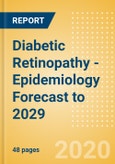Summary
Diabetic retinopathy is a sight-threatening microvascular eye complication of type 1 and type 2 diabetes, and is a leading cause of preventable visual disability and blindness in working-age adults throughout the world (Rubino et al., 2007). Only those with diabetes are at risk for diabetic retinopathy. Characteristically asymptomatic, diabetic retinopathy has few recognizable ophthalmic symptoms until the onset of actual visual loss (Fong et al., 2004). The pathophysiology of diabetic retinopathy stems from damage to the microvasculature of the retina due to prolonged metabolic changes induced by poorly managed diabetes (Williams et al., 2004).
The publisher epidemiologists utilized historical data obtained from peer-reviewed articles and population-based studies to build forecast for the diagnosed prevalent cases of diabetic retinopathy, diagnosed prevalent cases of DME, and diagnosed prevalent cases of RVO in the 9MM. The publisher's epidemiologists applied the prevalence of diabetic retinopathy, DME, and RVO drawn from the above sources to each country’s population to calculate the number of estimated diagnosed prevalent cases for diabetic retinopathy, DMV, and RVO respectively.
The following data describes the epidemiology of diabetic retinopathy. In the 9MM, the diagnosed prevalent cases of diabetic retinopathy are expected to increase from 14,267,247 cases in 2019 to 17,750,520 cases in 2029, at an Annual Growth Rate (AGR) of 2.44%. In 2029, China will have the highest number of diagnosed prevalent cases of diabetic retinopathy in the 9MM, with 6,975,178 diagnosed prevalent cases, whereas Australia will have the fewest diagnosed prevalent cases with 515,181 cases. In the 9MM, the diagnosed prevalent cases of RVO are expected to increase from 13,292,153 cases in 2019 to 15,722,813 cases in 2029, at an AGR of 1.83%.
Scope
Reasons to Buy
The Diabetic Retinopathy Epidemiology series will allow you to -
Diabetic retinopathy is a sight-threatening microvascular eye complication of type 1 and type 2 diabetes, and is a leading cause of preventable visual disability and blindness in working-age adults throughout the world (Rubino et al., 2007). Only those with diabetes are at risk for diabetic retinopathy. Characteristically asymptomatic, diabetic retinopathy has few recognizable ophthalmic symptoms until the onset of actual visual loss (Fong et al., 2004). The pathophysiology of diabetic retinopathy stems from damage to the microvasculature of the retina due to prolonged metabolic changes induced by poorly managed diabetes (Williams et al., 2004).
The publisher epidemiologists utilized historical data obtained from peer-reviewed articles and population-based studies to build forecast for the diagnosed prevalent cases of diabetic retinopathy, diagnosed prevalent cases of DME, and diagnosed prevalent cases of RVO in the 9MM. The publisher's epidemiologists applied the prevalence of diabetic retinopathy, DME, and RVO drawn from the above sources to each country’s population to calculate the number of estimated diagnosed prevalent cases for diabetic retinopathy, DMV, and RVO respectively.
The following data describes the epidemiology of diabetic retinopathy. In the 9MM, the diagnosed prevalent cases of diabetic retinopathy are expected to increase from 14,267,247 cases in 2019 to 17,750,520 cases in 2029, at an Annual Growth Rate (AGR) of 2.44%. In 2029, China will have the highest number of diagnosed prevalent cases of diabetic retinopathy in the 9MM, with 6,975,178 diagnosed prevalent cases, whereas Australia will have the fewest diagnosed prevalent cases with 515,181 cases. In the 9MM, the diagnosed prevalent cases of RVO are expected to increase from 13,292,153 cases in 2019 to 15,722,813 cases in 2029, at an AGR of 1.83%.
Scope
- The Diabetic Retinopathy Epidemiology Report provides an overview of the risk factors and global trends of Diabetic Retinopathy in the nine major markets (9MM: US, France, Germany, Italy, Spain, UK, Japan, Australia, and China).
- The report includes a 10-year epidemiology forecast for the diagnosed prevalent cases of diabetic retinopathy, diagnosed prevalent cases of diabetic macular edema (DME), and diagnosed prevalent cases of retinal vein occlusion (RVO).
- The diagnosed prevalent cases of diabetic retinopathy are segmented by age (20 years and older), sex, and severity (mild NPDR, moderate NPDR, severe NPDR, and PDR). Additionally, the RVO cases are segmented by age, sex, and type (branch retinal vein occlusion [BRVO] and central retinal vein occlusion [CRVO]). This epidemiology forecast also provides clinically significant macular edema (CSME) among the DME population, macular edema following BRVO, and macular edema following CRVO.
- The diabetic retinopathy epidemiology report is written and developed by Masters- and PhD-level epidemiologists.
- The Epidemiology Report is in-depth, high quality, transparent and market-driven, providing expert analysis of disease trends in the 9MM.
Reasons to Buy
The Diabetic Retinopathy Epidemiology series will allow you to -
- Develop business strategies by understanding the trends shaping and driving the global diabetic retinopathy markets.
- Quantify patient populations in the global diabetic retinopathy markets to improve product design, pricing, and launch plans.
- Organize sales and marketing efforts by identifying the age groups and sex that present the best opportunities for diabetic retinopathy therapeutics in each of the markets covered.
- Understand magnitude of diabetic retinopathy population by its severity.
Table of Contents
1 Table of Contents
2 Diabetic Retinopathy: Executive Summary
3 Epidemiology
4 Appendix
List of Tables
List of Figures








